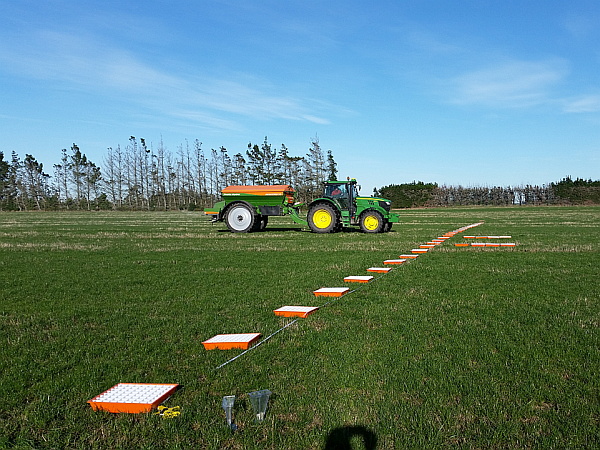With support from the New Zealand Asparagus Council (NZAC) and funding from Our Land and Water, we undertook a rapid project to investigate best practice for nitrogen management in asparagus crops.

It was a very difficult season for growers, with low prices, high staff shortages and the effects of the Covid pandemic. A number of growers did not harvest any crop this season. Many stopped their harvests early.
Although the project is “finished” we still have a little post-project work to do. We want to follow the crops over the next harvest to see what if any difference we can see after growers applied different rates of nitrogen fertiliser. So, with continuing support from the NZAC and growers, that’s our intention between now and Christmas.
What did we do?
- We did a literature review to see what others had found
- We surveyed a number of growers about fertiliser and nitrate management practices.
- We established five trials, two in Hawke’s Bay and one each in Mangaweka, Manawatu and Mid-Canterbury.
- We offered fertiliser spreader calibrations and used the fertspread tool to complete calculations and produce reports
- We ran a webinar discussing on-farm trials, and interpretation of soil test results
What have we found so far?

Literature review
We reviewed literature from New Zealand, US, USA and Germany and found a reasonable agreement between the different sources. In brief:
- Current nitrogen fertiliser recommendations are based on limited trial work
- Roots will grow to and extract nitrogen from at least 80 cm of soil depth
- Nutrient deficiency symptoms are not common and careful fern and root testing are needed to see if they exist
- While analysis of fern growth to assess nutritional status is recommended, little guidance on interpretation is given
- Soil testing should take in the whole root depth, but there are few guidelines to establish fertiliser rates
- Sufficient nitrogen fertiliser to grow healthy fern should be applied during the establishing years, though recommendations are few
- Once established application, if any, should be based on replacing nutrients removed during harvest, which is about 5 kg N/tonne of spears exported
- Research showed 75 kg-N/ha could support a crop for three years without a detectable change in fern nitrogen concentration
- Fertiliser should be applied close to fern growth which is when uptake occurs. This will minimise leaching risk, especially on shallow or low water holding soil types
Grower Surveys
From a posted survey and detailed surveys of trial growers, we compiled some industry generalisations.
- We found a wide range of nitrogen management practices, not indicative of a single agreed industry best practice
- Growers follow good practice transporting and storing fertiliser
- In general, fertiliser if any is applied at the end of harvest just before fern growth
- Surveys showed only some growers prepare formal documented nutrient budgets, but
- Most consider most of the relevant variables when determining how much (if any) fertiliser to apply
- Growers do keep good fertiliser application records
- About 60% of growers soil test annually, to 15 cm depth
- Equipment is generally checked for accuracy, and about half are formally certified

Fertiliser Trials
We need the yield data from the coming season to understand what, if any impact different rates have had on production.
- Limited yield data have collected so far, but what we collected and reported typical yields from our grower surveys are generally similar to those reported by Hunt et al. (2019).
- About 12 – 13 kg N/ha is exported in the harvested crop (some with high yields are more)
- Soil nitrate levels measured in late spring and summer were fairly consistent, but by the end of fern growth in winter, there was very little soil nitrate remaining
- Spring and summer nitrate must be from mineralised fern residues, some decayed roots, and nitrogen fixing microorganisms, as no fertiliser had been applied

Soil nitrate levels (kg NO3-N /ha) in upper 45 cm of profile by season as determined by the Nitrate Quick Test and FAR online conversion
- Some growers apply no fertiliser (especially this season)
- Some growers reported applying up to 69 kg N/ha

- Fresh root mass was highly variable with a minimum at the end of harvest, and a maximum at the end of fern growth.
- While roots can grow deeply, most of the soils in our trials had limitations from wetness or stones at about 45 cm.
- The fresh root mass in summer at the end of harvest was 26,300 kg/ha, increasing to 91,700 kg/ha in winter after fern growth
- The average concentration of NO3-N in root tissue was 1.38% of dry mass
- At the end of fern growth (which feeds spring spear production), about 80% or more of the nitrogen in the system was found in the roots
Data we collected are generally in line with published research.
Webinar
Covid and staff shortages left few growers able to travel to seminars. So we ran a webinar and discussed some of the key points for running on-farm fertiliser rate trials.
We are grateful to Alex Dickson for her presentation about interpreting soil tests. Taking report examples from the three main soil laboratories, Alex explained what the tests meant and how a grower can use the information.
We recorded the webinar, so you can view the presentations:
- On-Farm Trials (Dan Bloomer) https://youtu.be/o3fkFZmcG7A
- Interpreting Soil Tests (Alex Dickson) https://youtu.be/LaKMMII-lms
Many thanks to the growers hosting and supporting the trials, and the NZAC and Our Land and Water for support and funding.






 Tray layout for a spreader pattern test
Tray layout for a spreader pattern test